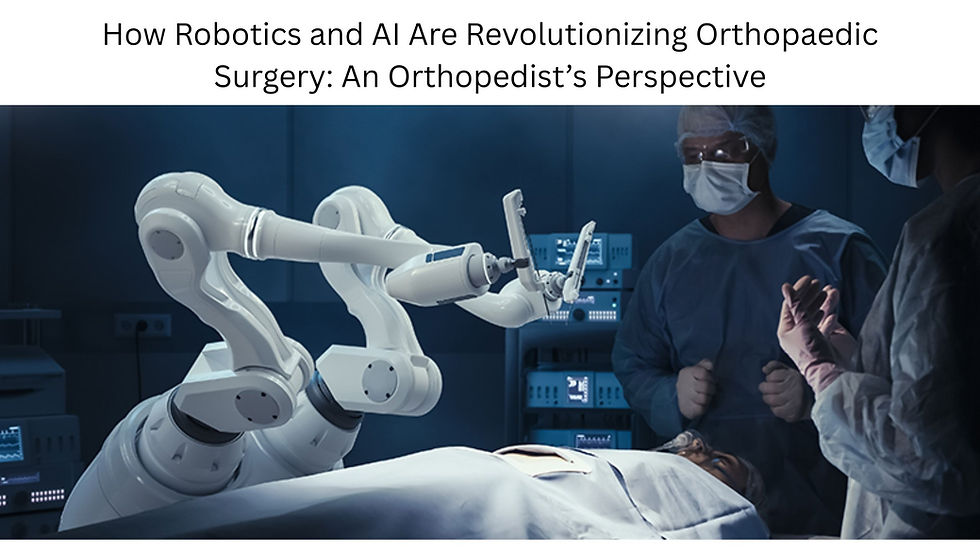How Robotics and AI Are Revolutionizing Orthopaedic Surgery: An Orthopedist’s Perspective
- creative9blogs
- Aug 18
- 3 min read

For decades, the art of orthopaedic surgery has relied on the immense skill, experience, and judgment of the surgeon. While that will always remain the cornerstone of our practice, we are now entering a new era where technology is providing us with a level of precision and insight previously unimaginable. As an orthopedist, I am thrilled to see how robotics and artificial intelligence (AI) are not replacing us, but rather empowering us to deliver even better care for our patients.
These advanced technologies are transforming every stage of the surgical journey, from pre-operative planning to post-operative recovery. They are helping us to perform procedures with a level of accuracy that was once reserved for science fiction, ensuring safer and more predictable outcomes.
Robotics in the Operating Room: A New Level of Surgical Precision
At the heart of this revolution is robotic-assisted surgery, which has made significant strides in procedures like knee and hip replacement. It’s important to understand that the robot doesn't perform the surgery on its own; it works as a sophisticated extension of the surgeon’s hands, providing unmatched precision.
Pre-operative Planning: Before a single incision is made, advanced software uses a CT scan of the patient's joint to create a detailed, three-dimensional (3D) virtual model. This allows the orthopedic doctor to meticulously plan the procedure, including the exact size, placement, and alignment of the implant. The Mako System is a great example of this, allowing for a personalized surgical plan based on a patient's unique anatomy. This digital blueprint helps the surgeon account for a patient's specific biomechanics, ensuring a better fit and more natural-feeling joint.
Intra-operative Guidance: During the procedure, the robotic arm provides real-time guidance and feedback to the surgeon. For example, systems like the NAVIO Surgical System use a handheld robotic tool to help the surgeon accurately prepare the bone surface for the implant. This technology provides haptic feedback, which allows the surgeon to "feel" the bone's density and resistance through the robotic arm. This ensures that only the diseased bone is removed, leaving healthy tissue intact. This combination of visual and tactile guidance minimizes human error, reduces the risk of complications, and leads to more precise implant placement.
The AI Advantage: Enhancing Every Step of the Patient Journey
Beyond the physical tools in the operating room, AI is working behind the scenes to enhance every aspect of patient care, from diagnosis to recovery.
Smarter Diagnostics: AI algorithms can analyze medical images, such as X-rays and MRIs, with incredible speed and accuracy. They can be trained to detect subtle fractures, signs of arthritis, or other abnormalities that might be missed by the human eye. This helps the bone doctor arrive at a quicker and more accurate diagnosis, enabling earlier intervention and a better prognosis.
Predictive Analytics: By analyzing vast datasets of patient records, surgical outcomes, and recovery data, AI can predict a patient's potential surgical outcomes and recovery timelines. This allows for a truly personalized treatment plan, helping the orthopedist anticipate potential challenges and provide proactive solutions. For example, AI can help predict a patient's risk of infection or readmission, enabling the surgical team to take preventative measures.
Post-operative Monitoring: The care doesn't stop after surgery. AI-powered wearables and sensors can monitor a patient's recovery at home, tracking things like gait, range of motion, and activity levels. This real-time data allows the orthopedic doctor to monitor progress remotely, ensuring the patient is on track with their physical therapy and healing process. If a patient’s progress plateaus or falls behind, the doctor can intervene early to get them back on track.
The Benefits for the Patient
The fusion of human expertise and advanced technology translates into a host of tangible benefits for you, the patient:
Enhanced Precision and Accuracy: Robotic systems ensure implant placement is precise to within a fraction of a millimeter, reducing the risk of misalignment and the need for future revision surgeries.
Minimally Invasive Procedures: The enhanced precision often means smaller incisions, less damage to surrounding muscles and ligaments, and less blood loss.
Faster Recovery and Shorter Hospital Stays: With less tissue trauma, patients often experience less pain, can start physical therapy sooner, and have a quicker return to their daily activities.
Improved Long-Term Outcomes: Accurate implant placement and a smoother recovery can lead to a more natural-feeling joint and greater long-term satisfaction with the results.
It's important to remember that robotic surgery is not about the robot taking over. It's about a highly skilled orthopedist using the most advanced tools available to perform a safer, more precise, and more predictable surgery. The surgeon remains in complete control, guiding the technology with their expertise and judgment.
The future of orthopaedic care is here, and it’s an exciting time to be a part of it. The combination of an expert orthopedic doctor and cutting-edge technology is creating a new standard of care, ensuring the best possible outcomes for every patient.




Comments